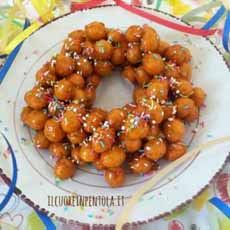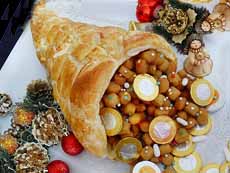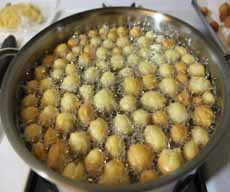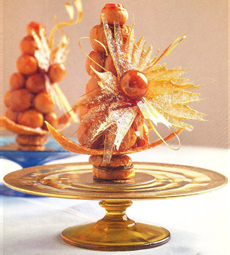TIP OF THE DAY: Struffoli, An Italian Christmas Tradition

|
How about a holiday baking project for family and friends?
If you don’t have your own holiday baking tradition like Christmas cookies, gingerbread people or spritz cookies, how about struffoli? Struffoli (STROO-fo-lee) are puffy balls of eggy fried dough coated in honey. They are a traditional Christmas sweet in Naples and other parts of central and southern Italy. The fried dough is stacked into a cone-shape centerpiece or assembled into a wreath design. More ambitious cooks have the puffs spilling out a pastry horn of plenty. We like to present it with after-dinner coffee. It’s actually quite easy: If you can fry, you can make struffoli. Struffoli look like a smaller, flat croquembouche. Both have a crunchy outside and soft inside. While struffoli can be served plain, you can express your creativity with decorations. This recipe, from 1,000 Italian Recipes by Michele Scicolone, can easily be doubled. It is © copyright Michele Scicolone. If you like the idea but not the labor, call the nearest Italian bakery and order one. Ingredients For 8 Servings 1. COMBINE the cup of flour and the salt in a large bowl. Add the eggs and lemon zest and stir until well blended. 2. TURN OUT the dough out onto a lightly floured board and knead until smooth (about 5 minutes). Add a bit more flour if the dough seems sticky. Shape the dough into a ball and cover with an overturned bowl. Let the dough rest 30 minutes. 3. CUT the dough into 1/2-inch-thick slices. Roll one slice between your palms into a 1/2-inch-thick rope. Cut the rope into 1/2-inch nuggets. If the dough feels sticky, use a teeny bit of flour to dust the board or your hands. (Excess flour will cause the oil to foam up when you fry the struffoli.) 4. LINE a tray with paper towels. Pour about 2 inches of oil into a wide heavy saucepan and heat to 370°F, or until a small bit of the dough dropped into the oil sizzles and turns brown in 1 minute. 5. PLACE just enough struffoli in the pan to fit without crowding, taking care not to splash the hot oil. Cook, stirring once or twice with a slotted spoon, until the struffoli are crisp and evenly golden brown (1 to 2 minutes). Remove with a slotted spoon or skimmer and drain on paper towels. Repeat with the remaining dough. When all of the struffoli are fried… |
|
|
6. GENTLY HEAT the honey to just a simmer in a large, shallow saucepan. Remove from the heat, add the drained struffoli and toss well. Transfer the struffoli to a serving plate and shape into a mound or wreath. Decorate as desired. 7. TO SERVE: For each person, break off a portion of the struffoli with two large spoons or a salad server. Or, pass the plate so people can take what they like. You can store struffoli at room temperature, covered with an overturned bowl, for up to 3 days. STRUFFOLI HISTORY The ancestor of struffoli dates back to ancient Greece. A similar dish is described by Archestratus, a Greek poet from Sicily. Called enkris, the dough balls were fried in olive oil (source). The name derives from the Greek word strongoulos, meaning “rounded in shape.” Fast forward to the early 17th century. The nuns of Naples were famous for their sweets, which they sold to the public. Each convent had a specialty. According to tradition, struffoli are considered good luck because the balls are a symbol of abundance. At Christmas, the nuns made struffoli as gifts for their aristocratic patrons, to thank them for their charity throughout the year. The tradition was copied by home cooks and became a Christmas tradition (source). |
||




